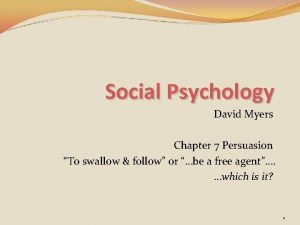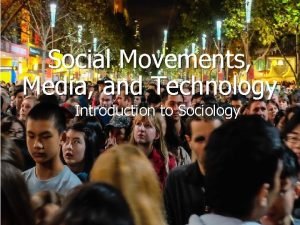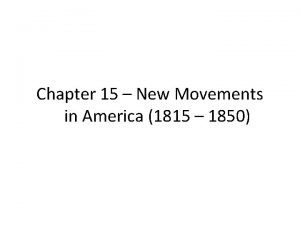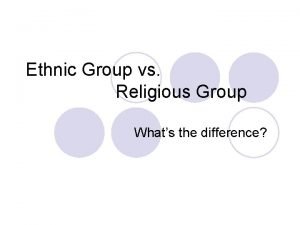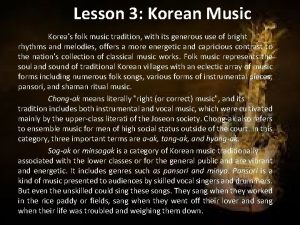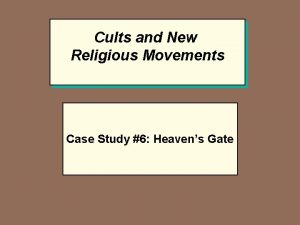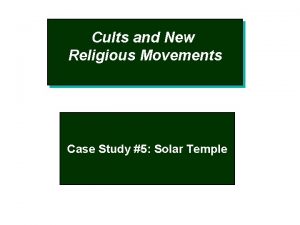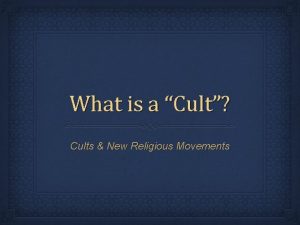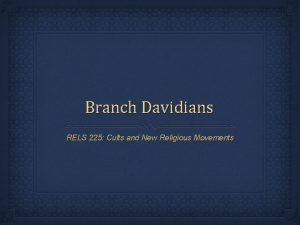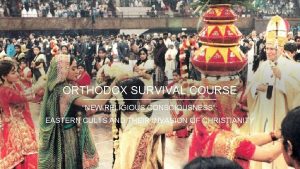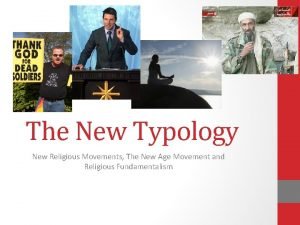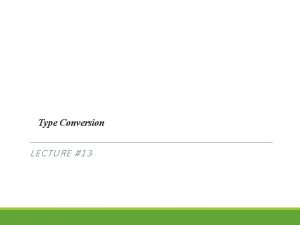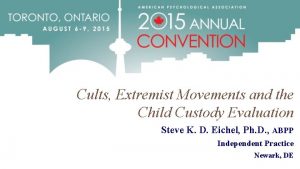Cults and New Religious Movements Conversion and Commitment
















- Slides: 16

Cults and New Religious Movements Conversion and Commitment

The Difficulty With Common Sense & Conventional Wisdom Sometimes common sense and conventional wisdom are unreliable Examples: • Those who live together before marriage have a better chance of a successful marriage than those who did not live together • Couples with children are happier than those who do not have children • The majority of those on welfare lazy and really don’t want to work Thus, we need to rely on systematic studies as opposed to anecdotal evidence to better understand the social world

Who Joins NRMs? The Stereotypes The young The idealistic The impressionable The gullible The uneducated The lonely The shy The poor

Why Do People Belong To Groups? Born into a group Compelled by authority to belong Elect to join Have a transformational experience

Why Join Religious Groups? The most important reason people belong to a religious tradition is not that they convert but that they were BORN into the tradition Throughout much of history, one’s religion was the religion of the ruler • The Roman Empire became Christian when the emperor Constantine embraced Christianity • Spain and Portugal conquered Latin America with the sword and the cross in the 15 th century Would you identify with your current religious tradition if you were born in India or Saudi Arabia? Nevertheless, conversions do occur But most faith affiliations have nothing to do with the classic conception of conversion (like Paul on the

Three Social-Scientific Models The Multidimensional Model The Relative-Deprivation Model (Glock) The Process Model (Lofland & Stark)

The Multidimensional Model Instrumental Commitment Sacrifice Investment Affective Commitment Renunciation Communion Moral Commitment Mortification Transcendence

The Relative Deprivation Model Until the 1960’s several social-psychological models prevailed These models suggested that people suffer some type of deprivation that motivated them to join a NRM • Deprivation could be economic, social, or psychological Members were assumed to be recruited from marginal segments of society Members were often assumed to have some sort of pathology Yet members of social movements and NRMs in the 1960 s were well adjusted, came from middle and upper class families, were highly educated, etc.

Thus, Glock argued that perhaps deprivation was relative rather than absolute Members only had to *believe* that they were deprived Argues that relative deprivation in some form is a necessary condition for the rise of an NRM

Critiques of The Relative Deprivation Model Often assumes that members have joined a NRM because they feel deprivation without testing to see if this is the case Does not cover the full range of factors that may contribute to joining a group E. g. pursuit of ultimate truth, join because their friends join, etc.

The Process Model (Lofland & Stark) Predisposing Conditions Tension Religious problem solving perspective Religious seekership

Situational Contingencies Turning point in life Development of emotional bonds to NRM members Weakening of extracult bonds Intensive interaction

Critiques of the Process Model Testing of theory has produced mixed results Snow & Phillips (1980) study on Nichiren Shoshu Greil & Rudy (1984) & 10 NRM case studies

So What Do We Know Based on the Research? Empirical research suggests the following generalizations Recruitment and conversion to NRMs happens primarily through pre-existing social networks with family and friends Strong ties to others in the NRM are important for recruitment and retention Sustained intensive interaction is also important for retention Members who are heavily involved have fewer and weake ties to non-members

Members have fewer and weaker ideological alignments outside of the NRM • The unchurched are more likely to join Seekership precedes many conversions

The Social Attributes of Members Typically in their 20 s and 30 s Generally well educated Generally from middle and upper middle social classes
 Extreme persuasion how do cults indoctrinate
Extreme persuasion how do cults indoctrinate What are the examples of axial movement
What are the examples of axial movement New social movements
New social movements New movements in america
New movements in america New movements in america section 1
New movements in america section 1 In a direct cutover conversion strategy
In a direct cutover conversion strategy In a direct cutover conversion strategy, the new system:
In a direct cutover conversion strategy, the new system: Religious symbolism in the old man and the sea
Religious symbolism in the old man and the sea Religious and classical roots
Religious and classical roots Cognitive and non cognitive religious language
Cognitive and non cognitive religious language Why does romeo use religious imagery
Why does romeo use religious imagery Public affairs and religious liberty
Public affairs and religious liberty Whats ethnic group
Whats ethnic group Folk songs religious works court music and shaman rituals
Folk songs religious works court music and shaman rituals How are ethnic groups and religious groups related
How are ethnic groups and religious groups related Hellenic ministry of education and religious affairs
Hellenic ministry of education and religious affairs Greek and roman art similarities
Greek and roman art similarities
